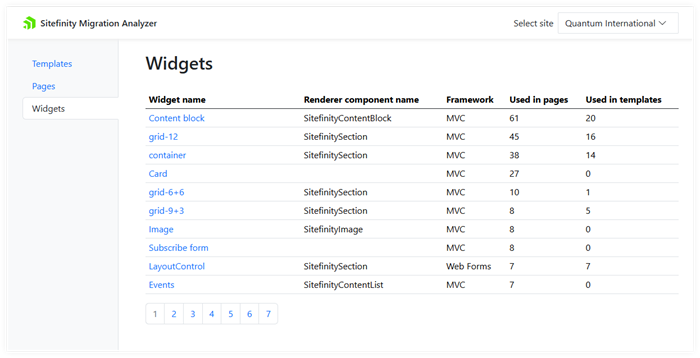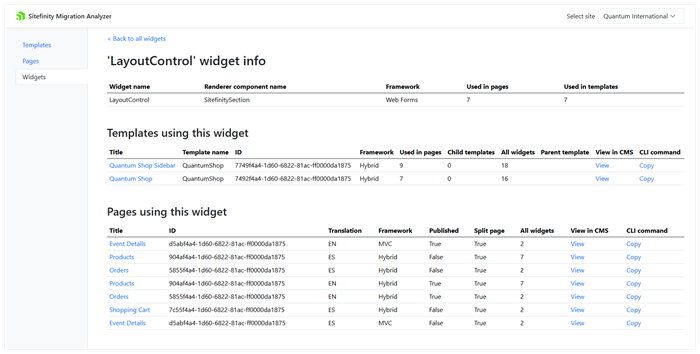Widgets
Overview
The following table provides information about the widgets used in the currently selected site:

The Widgets tab contains a table with the following information about your page templates:
| Column name |
Description |
| Widget name |
The name of the widget, as seen in Sitefinity CMS backend.
To see detailed information about the widget, click its name. |
| Renderer component name |
The developer name of the widgets based on Sitefinity decoupled renderers (ASP.NET Core and Next.js) that you can use to migrate this widget. |
| Framework |
The frontend framework used in the widget:
Web Forms, MVC, ASP.NET Core, or Next.js. |
| Used in pages |
The total number of pages in all Sitefinity CMS sites where this widget is used. |
| Used in templates |
The total number of page templates in all Sitefinity CMS sites where this widget is used. |
NOTE: Sort and filter
- You can sort all columns.
- You can filter the table by widget name. To create a filter, enter any text in the Search by title field and press Search.
The table will show only widgets whose names contain the text you entered.
To clear the filter, click  inside the Search by title field.
inside the Search by title field.
To export all the information from the Widgets tab, click  (Export in .csv). The Migration Analyzer generates a comma-separated values file (a .csv file), which you can open in programs such as Excel.
(Export in .csv). The Migration Analyzer generates a comma-separated values file (a .csv file), which you can open in programs such as Excel.
The name of the file is automatically generated and contains the following information:
Widget information
You click on a widget name to see the detailed information about it.
The following screenshot displays information about a widget:

In the ‘Widget name' widget info table, you see the following information about the widget:
| Column name |
Description |
| Widget name |
The name of the widget, as seen in Sitefinity CMS backend.
To see detailed information about the widget, click its name. |
| Renderer component name |
The developer name of the widgets from Sitefinity decoupled renderers (ASP.NET Core and Next.js) you can use to migrate this widget. |
| Framework |
The frontend framework used in the widget:
Web Forms, MVC, ASP.NET Core, or Next.js. |
| Used in pages |
The total number of pages in all Sitefinity CMS sites where this widget is used. |
| Used in templates |
The total number of page templates in all Sitefinity CMS sites where this widget is used. |
Templates using this widget
In this table, you see all page templates using the current widget.
| Column name |
Description |
| Title |
The name of the page template, as shown in Sitefinity CMS backend.
Click the page name link to navigate to a screen with details about the page template.
For more information, see Templates. |
| Template name |
The name of the page template, as used in the code. |
| ID |
The page template GUID, as used in the database. |
| Framework |
The frontend framework used in the template:
Web Forms, MVC, Hybrid (Web Forms + MVC), ASP.NET Core, or Next.js. |
| Used in pages |
The number of pages directly based on this template.
This number excludes pages based on child templates.
NOTE: The number includes pages in the Recycle Bin.
|
| Child templates |
The number of page templates that are direct children of this one. |
| All widgets |
The total number of widgets, based on any framework, which are used in this page template.
This number includes both custom and built-in widgets. |
| Parent template |
The template name of the parent page template.
This column is empty when this template does not have a parent one, or is based on a .master page (for Web Forms and Hybrid templates) or on a .cshtml file (for MVC). |
| View in CMS |
To open the page template in Sitefinity CMS backend, click the View link.
NOTE: You need to log in using an account with sufficient privileges.
|
| CLI Command |
When you click the Copy link, Sitefinity Migration Analyzer builds a command for Sitefinity CLI to migrate this page template to the decoupled frontend framework. The command is automatically placed in your OS clipboard.
To use this command, open your Terminal app, navigate to your Sitefinity CMS project’s source code, and invoke the Terminal’s Paste command (usually, the Ctrl+V keys).
Alternatively, you modify the generated command to include the path to your project.
PREREQUISITES:
- The CLI Command column is only visible when your project is based on Sitefinity CMS 15.3 or higher.
- You need Sitefinity CLI version 1.1.0.69 or higher to use the migrate command.
- You can use the Copy link only when your site is hosted under
localhost or using the https protocol.
For more information about using the migrate command, see Sitefinity CLI.
|
NOTE: You can sort the following columns: Title, Template name, ID, Framework, and Used in pages.
Templates based on ASP.NET Core and Next.js frameworks may not sort correctly by Framework when they are part of a deeply nested template hierarchy.
Pages using this widget
In the following table, you see all pages in all Sitefinity CMS sites that use the current widget:
| Column name |
Description |
| Title |
The title of the page, as seen in Sitefinity CMS backend.
To open detailed information about this page, click its name.
|
| ID |
The GUID of the page, as stored in the database. |
| Translation |
Shows the language of the page.
The column is empty when the page does not have multiple language translations or translations are synchronized for more than one language.
For more information, see Translate pages. |
| Framework |
The frontend framework used in the template:
Web Forms, MVC, Hybrid (Web Forms + MVC), ASP.NET Core, or Next.js. |
| Published |
True, if the page is in state PublishedFalse, when in another state.
For more information, see Content lifecycle.
|
| Split page |
A page is Split when its translations are independent and can have different widgets.
For more information, see Translate pages » Step 3. |
| All widgets |
The total number of widgets, based on any framework, which are used on this page.
This number includes both custom and built-in widgets. |
| View in CMS |
To open the page in Sitefinity CMS backend, click the View link.
NOTE: You need to log in using an account with sufficient privileges.
|
| CLI Command |
When you click the Copy link, Sitefinity Migration Analyzer builds a command for Sitefinity CLI to migrate this page to the decoupled frontend framework. The command is automatically placed in your OS clipboard.
To use this command, open your Terminal app, navigate to your Sitefinity CMS project’s source code, and invoke the Terminal’s Paste command (usually, the Ctrl+V keys). Alternatively, you modify the generated command to include the path to your project.
PREREQUISITES:
- The CLI Command column is only visible when your project is based on Sitefinity CMS 15.3 or higher.
- You need Sitefinity CLI version 1.1.0.69 or higher to use the migrate command.
- You can use the Copy link only when your site is hosted under
localhost or using the https protocol.
For more information about using the migrate command, see Sitefinity CLI.
|
NOTE: You can sort the following columns: Title, ID, Translation, and Framework.
NOTE: You may have a use case in which you placed a widget on a page template, set the Editable on pages flag, and assign this page template as a parent to a page. Optionally, you may have set another page template as a parent. In these cases, Sitefinity Migration Analyzer displays incorrect number of widgets on a page or that the specific widget is on the page, although you cannot see it.
You can ignore the incorrect information. If you delete that widget from the template, the Migration Analyzer will display the correct information.